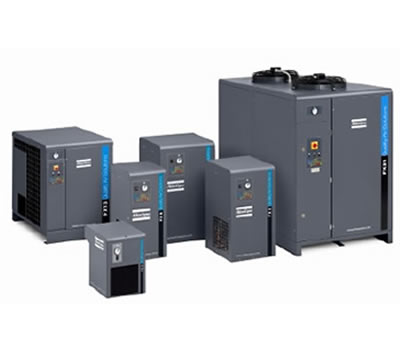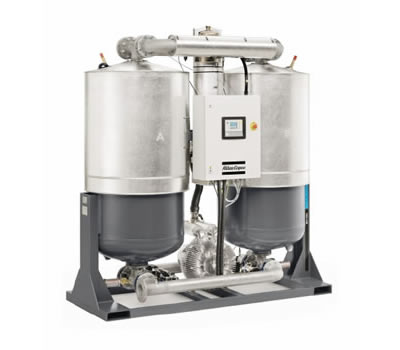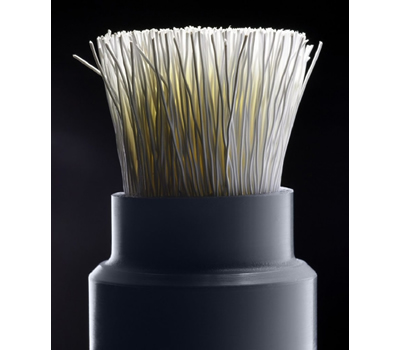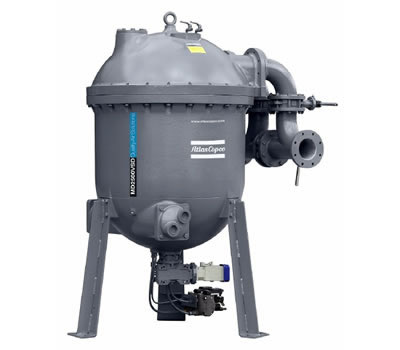Atmospheric contaminants, including water vapor, are concentrated when air is compressed. The dew point of the compressed air relative to free atmospheric air is thereby raised and leads to condensation downstream of the compressor within pipes, tools and equipment as the compressed air cools. Excessive liquid water or vapor in compressed air can cause a variety of problems including freezing air lines, equipment corrosion, and process or product contamination.
Drying air is much like squeezing water out of a sponge because, without pressure, it is difficult to remove much water. The higher the air pressure, or the harder you squeeze the sponge, the easier it is to remove water. A compressed air dryer can remove moisture from compressed air to a certain degree of dryness and this is referred to as pressure dew point. Different types of dryers can achieve different dew points and, for the most part, the drier air needs to be, the more expensive it is to dry. (The obvious exception to this is the Atlas Copco MD Series heat of compression rotary drum dryer that uses the energy of a 100 watt light bulb, yet achieves incredibly low pressure dew points.)
![]()

Refrigerated Dryers condense moisture out of the air and drain it away as liquid. Refrigerated Dryers are typically the least expensive in terms of initial cost and operational cost because they are simple and do not waste air. However, they are limited to about 35° F, because the water would freeze if it got any colder, so if the compressed air will be exposed to freezing temperatures, or if your process or product requires a lower dew point, another drying method will be required.
Refrigeration dryers employ two heat exchangers, one for air-to-air and one for air to refrigeration. However, there is also a single TRISAB heat exchanger that combines both functions. The compressors used in this type of dryer are usually of the hermetic type and the most common gas used is R-134a. The goal of having two heat exchangers is that the cold outgoing air cools down the hot incoming air and reduces the size of compressor required. At the same time the increase in the temperature of outgoing air prevents re-condensation.
![]()

Desiccant Dryers adsorb the moisture in the compressed air and remove it while still suspended as vapor. They are typically applied at about -40° F, but can get to -100 and below. While some desiccant dryers use a disposable element, most use dual towers that switch back and forth between drying air that is passed up through one tower while the accumulated moisture is purged down and out of the saturated tower. The cost to purge the saturated tower is significant, often consuming up to 15% of the compressed air, and it is expensive to "waste" this air so technology is applied to reduce it. Methods vary, from trying to maximize the switching cycles through timers or moisture sensors, to using external blowers and heaters to assist with the purge.
The term "desiccant dryer" refers to a broad class of dryers. Other terms commonly used are regenerative dryer and twin tower dryer, and to a lesser extent adsorption dryer.
The compressed air is passed through a pressure vessel filled with an adsorbent media such as activated alumina, silica gel, molecular sieve or other desiccant material. The desiccant can bring the dewpoint of the water vapor in the air down to -40 degrees Celsius or below. This means that the air will not condense (deposition) water until it is cooled to -40 degrees Celsius. In practice two cylinders with desiccant are used; one is drying the air, while the other vessel is being regenerated. The switching of the vessels and the regeneration sequence is typically done automatically via solenoid operated valves.
The regeneration of the desiccant vessel can be during three different methods:
* Heatless "pressure-swing" drying which uses part of the
dry compressed air coming from the other vessel to dry the desiccant
in the vessel being generated at lower pressure.
* Heated dryer, this can use a hot air blower, so there is no loss of compressed
air.
* Heat of compression. This can only be used with an oil free compressor.
![]()

Membrane dryer refers to a dehumidifying membrane that removes water vapor from compressed air. It is used in pneumatic components, air bearings, air spindles, medical equipment, air guns and pneumatic brakes for vehicles & trains.
Membrane Dryers use permeability to separate the moisture from the air and can also achieve low dew points. Thousands of tiny fibers, about the diameter of a human hair, are encapsulated in a tube and compressed air is fed into them. Dry air permeates to the outside of the fibers while the moisture laden air is purged from the system. This cost of the high purge rate is offset by the simplicity of the design and the fact that, with no electricity required, the are intrinsically safe, making them ideal for point of use in explosive environments such as paint spray booths.
![]()

The Atlas Copco MD Series rotary drum dryer uses heat of compression to dry air to -13° F and are often selected for applications where refrigerated dryers are suitable due to the significant energy savings they offer. Since heat of compression is a byproduct of compressing air, the MD dryer simply rotates the drum and requires negligible energy input.
Select below to send your request
by email to an appropriate product specialist.
Please include your contact information (name, phone, email,
company, location, etc.) and a full description of your needs.
We will contact y0u shortly.
Equipment Service or Parts